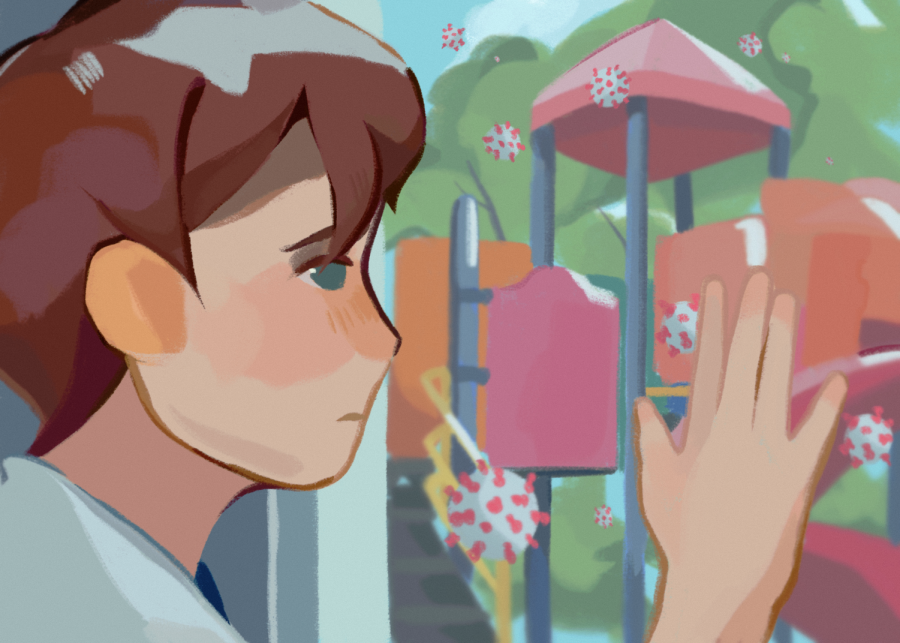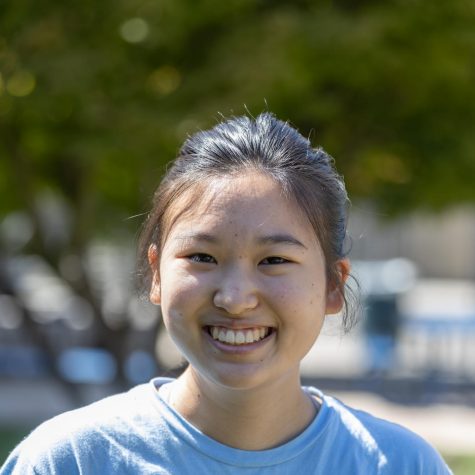Amidst limited social interaction, distance learning and rapidly changing safety regulations, children have been forced to adapt to their often irregular environments. After talking to experts and parents alike, The Talon has created a comprehensive guide to the social, emotional, and physical effects that the pandemic has had on the development of children of all ages.
Baby steps toward child development in a pandemic
February 8, 2021
For many children, playing with friends in the local park’s sandbox and perfecting pirouettes in their dance class has been replaced with countless hours spent staring into a screen. COVID-19 has forced people of all ages inside, but what does that change mean for children in key developmental stages?
Here’s what we’ve found after talking to Los Altos–based pediatrician Dr. Orchid Ghaffari, Foothill College child development instructor Maria Dominguez and Los Altos High School AP Government teacher Sarah Carlson about the effects of the pandemic on children. Ghaffari has been in practice for 20 years; Dominguez received a master’s in education with a concentration in early childhood education, followed by 20 years as a preschool teacher, and now teaches classes about her field at Foothill; and Carlson is a mother to young twins.

While talking to these various sources, we quickly realized how expansive the social and physical effects of the pandemic are, but also that everyone’s experiences have been distinctively diverse. In regard to children, the severity of the impacts of quarantine depends not only on their age but also on their home lives.
“Two children living on the same block could have two very different experiences,” Dominguez said. “Those differences have everything to do with the adults they live with. Children are very sensitive and feed off of adults’ energy, so if there are financial pressures or a lot of conflict in the home, it will heavily affect children.”
Breaking the news
Since the start of the quarantine in March 2020, parents have faced the unprecedented task of explaining an abstract, complicated virus and its ever-changing consequences to their children.
Kids often sense a major issue or source of stress through implicit changes to their environments, even before they are explicitly informed of it by their caregivers. By picking up on fluctuations in the emotions and body language of those around them or overhearing the anxious tones underscoring adult conversations about the virus, children often internalize those fears.
“There’s a lot of fear,” Dominguez said. “They might not even know what they’re scared of because they haven’t held it or seen it.”
Children are only capable of expressing their adopted fears in the limited capacity and logic they have developed thus far, which mirrors their minimal understanding of the issue itself. When they’re young, enemies such as abstract viruses are too complex for their still-developing thought process, so their minds tend to translate it into something more tangible.
Dominguez described how one preschooler refused to go downstairs by herself after learning about the existence of the virus. In this 4-year-old’s case, the virus was more comprehensible as an intruder in her house, which she could avoid by never being alone downstairs.
“Children are egocentric, thinking only about themselves, so they might worry that they are at fault for the virus and feel they have to do the right thing or somebody will get sick,” Dominguez said. “They make up a scary situation in their minds because they know something’s up, but they don’t quite know what it is.”
In order to prevent situations like these, Dominguez recommends that parents talk about the virus in the presence of their kids but not the gravity of its effects. She advises parents to make the situation more concrete and positive by discussing what scientists and healthcare professionals are doing to improve the situation, as well as how everyone can take care of themselves.
“The younger you go, the more confusing the virus becomes because it’s airborne, and you can’t see or touch it,” Dominguez explained.
Social development
Considering how rapidly children grow — mentally, physically and emotionally — we have broken down the stages of social development in children by age to provide an in-depth understanding of how the behaviors, skills and thoughts of kids of all ages are affected by the pandemic.
0–2 years
Due to their limited awareness of their surroundings, caregivers can fulfill the majority of social interaction required for the proper development of infants. To gain an insight into the experiences and takeaways of a “pandemic parent,” we talked to AP Government teacher Sarah Carlson, a mother to 1-year-old twins who have been in quarantine for most of their lives. She’s found this time to be simultaneously one of the most rewarding and isolating experiences to have had as a parent.
“The increased time spent at home means I have been there for most milestones and have had a huge opportunity to bond with my children in their first year of life,” Carlson said. “I am deeply grateful for the additional time I have gotten to spend with my son and daughter.”
On the other hand, she and her wife are unable to share these special moments with their extended family and loved ones, and also feel disconnected from other new parents going through the same experiences.

“It is also a somewhat lonely time to be a new parent,” Carlson said. “It is a major transition to go through and while it is possible to have some conversations with fellow parents online or at a distance, I really look forward to the day when I can attend playgroups with my kids freely and bond with fellow parents in person.”
Though their outings have been limited, her children have gotten used to seeing people wearing masks and will still smile and engage with them, rather than shy away. Though, with less exposure to seemingly everyday activities like going shopping, they haven’t grasped the relationship between their toys and the objects they would see in the real world.
“They got a toy wallet with toy coins and credit cards, but they have no idea what it is because they have never seen us pay for anything in a store,” Carlson said. “We don’t take them to many places because they can’t wear masks yet, so their world is pretty small.”
Carlson isn’t too worried about the pandemic’s lasting effects on her children and predicts only small changes. One of her worries is that her twins might find being left with a babysitter difficult the first time because of their limited interactions with adults other than their caregivers.
“I hope that having the time to bond so intensively as a family this year will help them have a strong foundation in life and that the pandemic will mostly be over by the time they start forming lasting memories,” Carlson said.
Ghaffari confirmed that newborns and children under the age of two can develop all the social skills expected of their age group from their immediate family, but once they get older, it becomes imperative to introduce them to other influences and peers.
“Before starting preschool, children focus on parallel play, meaning that they get excited when they get to see each other, but then proceed to do their own thing,” Ghaffari said. “Preschool starts at two years and nine months exactly because that’s right at the age when children start actually playing together for a little while.”
3-4 years
After the egocentric mindset of infancy, toddlers progress and develop a new social awareness through peer-to-peer interactions. They learn how to effectively interact with other kids, make purposeful decisions and hone their language skills all through play.
“They’re learning to take turns and share their toys with other peers,” Ghaffari said. “Whether they’re building something together or just showing interest in other people’s activities, they learn by imitating each other.”
Without their human peers, some isolated children have started mimicking the behavior of their pets, and parents have taken to TikTok to document these unusual experiences. One parent shared a video of her baby foregoing her hands and shoving her face into food like a dog. Another baby started shaking her head as a dog does when playing with a toy, and yet another showcases a baby’s babble resembling barks more than human speech.
Although they will likely grow out of these “animalistic” traits, it’s a testament to children’s tendency to learn from their immediate surroundings, whether it be a parental figure or just their pet.
@hazelandrioInstead of talking, we “bark” ? and that’s on being a quarantine baby surrounded by dogs ##toddlersoftiktok ##huskiesoftiktok ##switchthechobaniflip♬ Can We Kiss Forever? – Kina
5–6 years
Entering kindergarten and leaving behind the comforts of home is a big step (metaphorically, of course. Their legs are still so tiny!) for any toddler, but if the child has had little to no peer exposure, that step requires some serious stretching.
“They might need a little confidence boost when they need to start kindergarten and form friendships all of a sudden,” Dominguez said. “Friendship building skills can eventually be strengthened, but it might take more time than usual.”
Kindergarten exposes 5- and 6-year-olds to longer, more sustained interactions with unfamiliar people for the first time — a step critical to their natural progression into elementary school. However, the development of social skills requires in-person interactions and already has a steep learning curve. This portion of young kids’ growth is much more difficult to supplement in a virtual environment.
In distance learning, students are expected to maintain focus while staring into a two-dimensional screen, which gives teachers the Herculean task of keeping their students’ attention long enough to educate them. Ghaffari expects there might be longer-term focus or attention issues as a result of distance learning, but said it’s difficult to know for sure as of now because of the short cycle of experimentation.
“The students’ attention spans aren’t great while sitting in front of the screen, so teachers have modified the class schedule to include more breaks for them,” Ghaffari said.
Dominguez acknowledges that kindergarten teachers are truly making an effort to be interactive and physical despite being online, but children learn by doing, touching and taking part in activities, which makes it difficult for them to sit for long periods or concentrate on their tasks.
“It breaks my heart every time I see a young child on their device because children are just so much more joyous when they are interacting with other children,” she said.
It’s pretty common to see attention deficits from children in this age range, but Ghaffari advises parents to incorporate physical and creative activities such as building projects and coloring books into their at-home learning. This change can help progressively boost the child’s attention span outside of class and prevent a lack of focus in the future.
Other than that, Ghaffari hasn’t noticed many budding long-term effects like a lack of empathy from the quarantine in her young patients. However, she takes that with a grain of salt considering she doesn’t witness their daily interactions like parents and teachers do.
In general, alluding to the patterns she’s seen at her clinic, Ghaffari is hopeful that young kids will come out of this pandemic relatively unscathed.
13–18 years
Although the effects of the pandemic may not be as immediately apparent on teenagers, young adults have also missed out on important milestones, like graduation and prom, that many have looked forward to throughout their childhood and high school years.
“It’s so easy to keep the younger kids distracted and make them happy, but the bigger disappointments have been for the teenagers,” Ghaffari said. “There’s just so much disappointment that they have to deal with. Also, it has been hard to try to find routines to keep moving forward and not let the pandemic get them down.”
On the bright side, the obstacles faced during the pandemic may make the transition into adulthood less dramatic, as teenagers develop a more realistic mindset. After going through a global lockdown and being forced to grow up a little faster, life changes hopefully won’t faze them as much.
“As teenagers get older and things don’t go their way, they may start thinking, ‘At least it’s not a pandemic,’” Dominguez said. “Instead of being affected by disappointment, they might change their mindset to ‘All right, let’s just move on. We got this!’”
Return to school
Heading back to the classroom would allow children to see their peers and return to hands-on learning, but it’s important to consider the potential downsides. Beyond potentially spreading COVID-19, rushing the return process may lead to non-viral consequences such as anxiety or trust issues among students.
For instance, Dominguez’s sixth-grade nephew struggled with the return to school due to the unpredictability of another closure. A couple of days after his elementary school opened for in-person learning, students were sent back home because of a spike in COVID-19 cases.
“I would keep kids home,” Dominguez said. “Right now, they’re in a familiar place at home, and although lacking in interactions, it’s stable. If they go to school and somebody gets the virus, they’re back home for three weeks. It’s just constant disruption, which is more damaging for children.”

When doing virtual learning, kids who don’t receive as much attention and interaction from their immediate family as they would from their friends and teachers at school are struggling to keep up with their online schoolwork and social life.
The return to school doesn’t just affect the students, though. As a result of both work and life happening in the same area — with kids trampling over the already blurred line between the two, many working parents are awaiting their children’s return to physical school. In some large families, parents have had to juggle supervising multiple children, while also acting as an educator for their kids who are having (technical) difficulties with online school.
Despite this difficult transition to distance learning, some families have grouped together in pods to provide their children with regulated social interaction. It also gives parents the opportunity to divide and conquer, offering a welcome reprieve from constantly supervising their children. Some parents also use these “pandemic pods” to invest in additional online learning programs and share curriculum within the group.
Physical development
Without outdoor play at school, the responsibility of providing opportunities for their children to exercise falls to parents. Both fine and gross motor skills, the ability to use small and large muscle groups, respectively, must be strengthened through physical activity and practice to adequately perform everyday tasks.
If fine motor skills like wrist stability while holding a pencil aren’t practiced regularly, for example, students may not be able to improve their strength and control, causing their muscles to become sloppy and weak, Dominguez explained. Gross motor skills such as running and throwing are less likely to be impacted since large muscles in the limbs and torso are used in almost all activities, but could still be negatively affected if not practiced properly and regularly.
There’s a delicate balance between preventing COVID-19 health risks and giving children peer to peer interaction. Ghaffari suggests some of these safe solutions. Small childcare facilities with families all working from home and creating a pod with close friends are some great ways to keep children safe while allowing them to partake in these new experiences.
Parents play a huge role in a child’s physical development, and that’s only increased during the pandemic. Ghaffari advises parents to find a balance between work, exhaustion, and spending time with their child to prevent many concerns about future development issues.
“Definitely take them outdoors, read together and shut off the screen as soon as the class time is over,” Ghaffari said. “It takes effort, but it’s much better in the long run.”
Moving forward
It’s hard to know how the pandemic will affect children’s development in the long-run. But living through such a life-changing year will most definitely teach them to accept and embrace change.
“Emotional development is one of those areas where you always continue learning because humans change and the world changes,” Dominguez said. “Children are resilient, and it’s amazing what they can go through. They’re forced into another level of maturity not necessarily because they chose that, but because that is their reality.”
Both Ghaffari and Dominguez aren’t too concerned about dramatic overall emotional consequences for children from the pandemic, but they are aware of a number of small-scale ones. For example, after being constantly reminded to wash their hands and wear their masks, kids may value sanitation more.
We — non-professional high school seniors — have some predictions of practices that might create lasting impacts. For example, we grew up learning “sharing is caring,” but young kids are being taught to “keep their hands to themselves” during the pandemic because of the significant consequences of spreading germs.
“We’re going to have a generation that is a lot more careful about germs because when you’re little, and you learn things for the first time, they stay with you,” Dominguez said. “If this is the world they’re living in, these are going to be the young adults that walk around with hand sanitizer and are very careful about things because their brain is being wired right now.”
Although the pandemic has dramatically altered children’s day-to-day lives for nearly a year, Dominguez, Ghaffari and Carlson are hopeful that children will come out of it healthy, with a life lesson or two.
“I try to reassure families that the most important thing is to keep them healthy right now and not worry so much,” Ghaffari said. “If we can still keep everybody healthy, then moving forward, the empathy, sense of community and connectedness will grow.”






